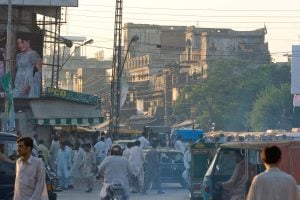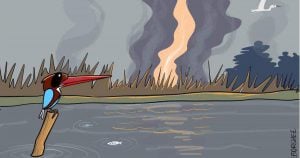Global warming is transforming the ecosystem of the Arabian Sea, new research has found. Scientists have linked snow melting in the Himalayas to the loss of important plankton more than 1,000 miles away, which is affecting fish populations and the fisheries and coastal people that depend on them.
As snow and ice melt in the Himalayan mountains, the winter winds that blow down from them are becoming warmer and more humid, the researchers say. This alters the currents of the Arabian Sea and distribution of nutrients – and in turn the marine food chain, with fish struggling in the new conditions. This is happening at a much faster rate than that predicted by global models, the study says.
The Arabian Sea is a unique marine ecosystem in the Indian Ocean. Its currents are controlled by monsoon winds that reverse direction in summer and winter. Normally, during the summer south-west monsoon season, winds and the rotation of the Earth bring cold, nutrient-rich waters to the surface. During winter, the cold north-east monsoon winds chill surface water, causing it to sink and deeper waters to rise. The mixing of waters fertilises them, and tiny ocean plants and microorganisms proliferate, which fish feed on.
Major ecosystem changes
Global warming has had a “disproportionately strong influence on the Eurasian land surface”, the team of scientists from China, Oman and the US say in their report. The result is a steady decline in snow cover over the Tibetan Plateau region of the Himalayas.
Joaquim Goes is Lamont research professor at the Lamont-Doherty Earth Observatory at Columbia University in the US and one of the authors of the new study. He told The Third Pole that research by his team published in 2005 found that the summer monsoon winds were becoming stronger because of the melting of snow on the Himalayan-Tibetan Plateau. This was creating conditions for phytoplankton to increase.
“The new study shows how the snowmelt on the Tibetan Plateau is continuing along the same trajectory [whereby snow melting causes the monsoon to change and more marine plants to grow] into the winter monsoon too,” Goes said.
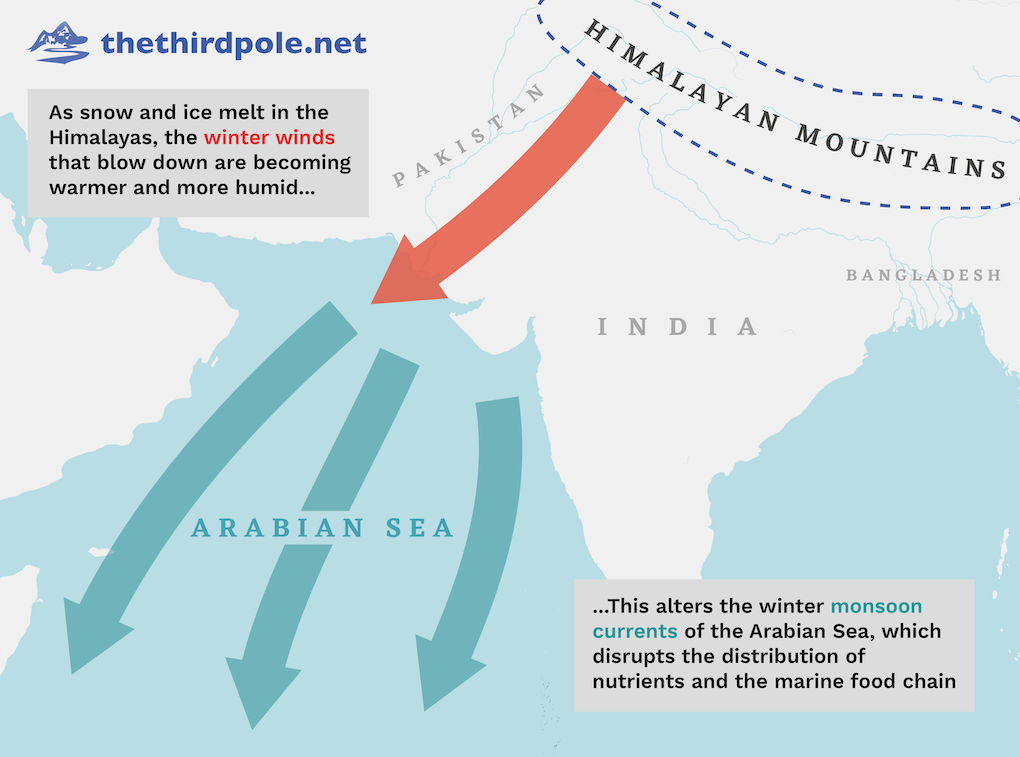
As the snow melts, less sunlight is reflected back into the atmosphere, warming the Indian landmass. This means the north-east monsoon is warmer and more humid, so does not cool surface waters as much as it used to. The new study says this is “undermining” the mixing of waters during winter. It adds that over the past 40 years, the Arabian Sea has had “a profound loss of inorganic nitrate”. This is because larger quantities of sea plankton use more oxygen to produce energy. As the mixing of the waters slows down, oxygen-deficient zones increase, and the microbes instead degrade nitrates to produce energy.
See: Cyclones batter South Asia as Indian Ocean heats up
The oxygen-deficient zones across the Arabian Sea support algal growth. Typically such areas occur at depths of 180-1,000 metres in the ocean, Goes said. But these zones now happen at 100 metres in the Arabian Sea, especially near the coast of Oman. This is because less oxygen gets into the water when the surface is warmer, he explained.
Both events – the reduced mixing of nutrient-rich waters and the loss of nitrate – affect the food chain. Organisms that make food solely by photosynthesis (using sunlight to convert water and carbon dioxide into carbohydrates and oxygen) are adversely impacted, whereas mixotrophs (organisms that make food from more than one source) survive.
The study shows that the warmer conditions are particularly favourable for Noctiluca scintillans, a parasite type of algae which is replacing a group of algae called diatoms. Diatoms, which were previously the dominant organism, are an important source of food for fish.
Noctiluca scintillans, also called ‘sea sparkle’ because it emits light at night, is growing explosively in patches called blooms in the north Arabian Sea. The blooms this summer have been so big they can be seen from space.
The blooms reduce the amount of oxygen in the water, which can kill fish. A 2017 study on the Sea of Oman found a significant correlation between algae blooms and fish dying due to the decline in oxygen.
Their expansion in the seas represents a “significant and growing threat” for regional fisheries and coastal populations dependent on the Arabian Sea for food, the scientists say.
See: Diving against debris in the Arabian Sea
Roxy Mathew Koll, a scientist at the Indian Institute of Tropical Meteorology in Pune, studies microscopic marine organisms in the Indian Ocean and his work was cited in the study. He said that the research is broadly similar to his team’s findings, which also points to a significant change in marine phytoplankton in the Indian Ocean.
But, Koll said, the two sets of similar findings were for different seasons. “Our study showed that the rapid warming in the Arabian Sea is reducing the phytoplankton concentrations during summer,” he said.
The new study says that the changes over Eurasia are affecting the winter conditions in the north Arabian Sea, increasing the concentration of phytoplankton that causes harmful algal blooms, said Koll.
“So the response of marine phytoplankton is different in summer and winter, but both studies show how global warming is detrimental for the marine ecosystem,” he said.
Some contest findings
VVSS Sarma, senior principal scientist at India’s National Institute of Oceanography has a different theory. He said the changes are not due to global warming but natural variations in ocean cycles. Sarma’s team has collected years of data on ‘primary production’, the rate at which tiny marine plants produce food. He said the data does not show the trend identified by the new study, and that the amount of biomass being produced in the Arabian Sea remained more or less constant. Sarma said this showed the absence of climate change-driven changes.
Sarma cited research published in 2012, which disputes the 2005 findings by Goes’ team that the amount of plankton in the water was linked to snow melting in the Himalayas. The 2012 paper said that “the earlier [2005] observed biological changes in the western AS [Arabian Sea] could be an artefact of the change in local winds and ocean dynamics, which may be a part of the natural long-term variability”. The changes are, therefore, not due to climate change, according to the 2012 research.
Sarma added that his team’s analysis of models used in the Indian Ocean showed that “none of the global models work in the Indian Ocean due to unique geography, human impact with more than 30% of the world population dwelling along the northern Indian Ocean coast – which were not factored in by the global models”.
Goes said natural cyclical changes may contribute, but that human activity-induced global warming should not be discounted.
![<p>Algae blooms in the Arabian Sea seen from space [image by Norman Kuring/NASA]</p>](https://dialogue.earth/content/uploads/2020/06/algae-blooms-in-the-Arabian-sea-1-scaled.jpg)
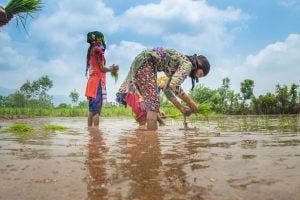


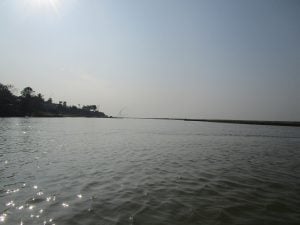
![A resident of Tetelisara village in Assam’s Nagaon district carries out his foodgrain stock during Assa, floods Nagaon May 2020 [image by: Diganta Talukdar/Alamy]](https://dialogue.earth/content/uploads/2020/06/Assam-floods-300x200.jpg)
![Tourists on elephants take photos of rhinos in Kaziranga National Park [image by: Sadiq Naqvi]](https://dialogue.earth/content/uploads/2020/06/tourists-on-elephants-take-photos-of-rhinos-in-kaziranga-file-photo-Nov-2019-300x225.jpeg)
